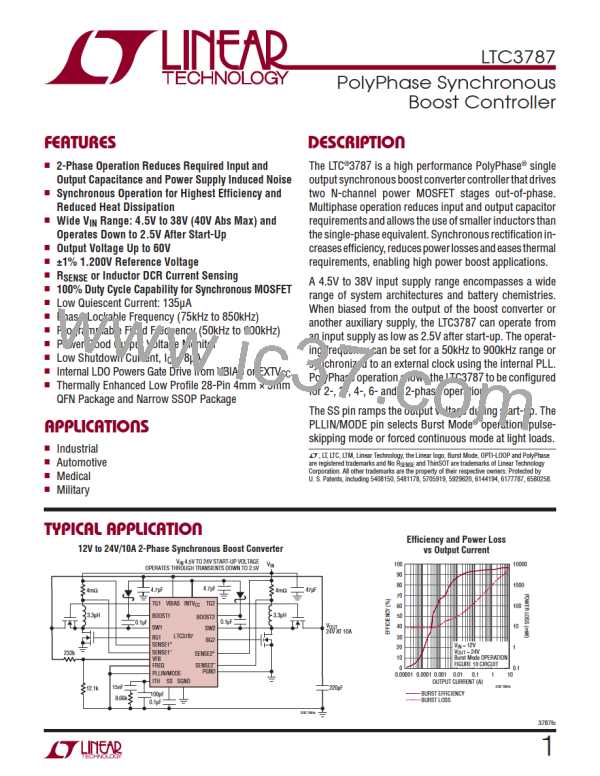LTC3787
APPLICATIONS INFORMATION
Power MOSFET Selection
power dissipations in each channel at maximum output
current are given by:
Two external power MOSFETs must be selected for each
controller in the LTC3787: one N-channel MOSFET for the
bottom (main) switch, and one N-channel MOSFET for the
top (synchronous) switch.
2
I
⎛
⎞
(VOUT − V )VOUT
OUT(MAX)
IN
V2
PMAIN
=
•
• 1+ δ
(
)
⎜
⎟
2
⎝
⎠
IN
IOUT(MAX)
• RDS(ON) +k • V3
•
The peak-to-peak gate drive levels are set by the INTV
voltage. This voltage is typically 5.4V during start-up
CC
OUT
2• V
IN
(see EXTV pin connection). Consequently, logic-level
threshold MOSFETs must be used in most applications.
CC
• CMILLER • f
2
Pay close attention to the BV
MOSFETs as well; many of the logic level MOSFETs are
limited to 30V or less.
specification for the
DSS
I
⎛
⎞
V
VOUT
OUT(MAX)
IN
PSYNC
=
•
• 1+ δ •R
DS(ON)
(
)
⎜
⎟
2
⎝
⎠
where δ is the temperature dependency of R
(ap-
DS(ON)
Selection criteria for the power MOSFETs include the
proximately 1Ω) is the effective driver resistance at the
MOSFET’s Miller threshold voltage. The constant k, which
accounts for the loss caused by reverse recovery current,
is inversely proportional to the gate drive current and has
an empirical value of 1.7.
on-resistance R
, Miller capacitance C , input
DS(ON) MILLER
voltage and maximum output current. Miller capacitance,
, can be approximated from the gate charge curve
C
MILLER
usually provided on the MOSFET manufacturer’s data
sheet. C is equal to the increase in gate charge
MILLER
2
BothMOSFETshaveI RlosseswhilethebottomN-channel
along the horizontal axis while the curve is approximately
flat divided by the specified change in VDS. This result
is then multiplied by the ratio of the application applied
VDS to the gate charge curve specified VDS. When the IC
is operating in continuous mode, the duty cycles for the
top and bottom MOSFETs are given by:
equation includes an additional term for transition losses,
which are highest at low input voltages. For high V the
IN
high current efficiency generally improves with larger
MOSFETs, while for low V the transition losses rapidly
IN
increasetothepointthattheuseofahigherR
device
DS(ON)
withlowerC
actuallyprovideshigherefficiency.The
MILLER
VOUT − V
synchronous MOSFET losses are greatest at high input
voltage when the bottom switch duty factor is low or dur-
ing overvoltage when the synchronous switch is on close
to 100% of the period.
IN
Main Switch Duty Cycle =
VOUT
V
VOUT
IN
Synchronous SwitchDuty Cycle=
The term (1+ δ) is generally given for a MOSFET in the
IfthemaximumoutputcurrentisI
andeachchan-
OUT(MAX)
form of a normalized R
vs Temperature curve, but
DS(ON)
nel takes one half of the total output current, the MOSFET
δ = 0.005/°C can be used as an approximation for low
voltage MOSFETs.
3787fc
18

 Linear Systems [ Linear Systems ]
Linear Systems [ Linear Systems ]